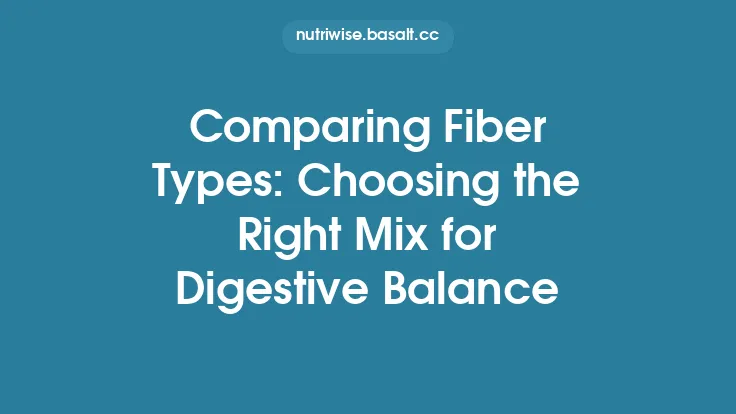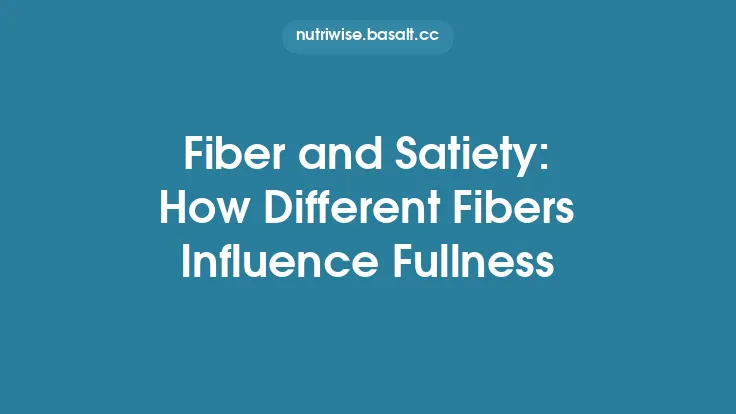Soluble fiber is a distinct class of dietary carbohydrate that dissolves in water to form a gel‑like substance within the gastrointestinal (GI) tract. Unlike many other components of the diet, it is not digested by human enzymes; instead, it traverses the upper GI tract largely intact before undergoing selective interactions that influence digestion, nutrient absorption, and overall gut health. Understanding how soluble fiber works provides a foundation for making informed dietary choices that support a well‑functioning digestive system.
What Is Soluble Fiber?
Soluble fiber refers to a heterogeneous group of plant‑derived polysaccharides, oligosaccharides, and lignin‑like compounds that possess the ability to become hydrated and form viscous solutions or gels when mixed with aqueous fluids. The defining characteristic is solubility in water at physiological temperatures, which distinguishes it from insoluble fiber that remains largely unaltered by water.
Key points:
- Non‑digestible by human enzymes – α‑amylase, pancreatic amylase, and brush‑border disaccharidases cannot hydrolyze the β‑glycosidic linkages typical of soluble fibers.
- Fermentability – While many soluble fibers are fermentable by colonic microbiota, the primary focus here is on their mechanical and chemical actions in the small intestine and colon that affect digestion.
- Molecular diversity – Soluble fibers encompass a range of molecular weights, branching patterns, and functional groups, which together dictate their physicochemical behavior.
Chemical Structure and Solubility Characteristics
The solubility of a fiber is largely a function of its molecular architecture:
| Structural Feature | Typical Soluble Fiber Example | Effect on Solubility |
|---|---|---|
| Linear β‑(1→4) glucose chains with occasional branching | Pectin | High water affinity; forms a smooth gel |
| β‑(1→3) and β‑(1→4) linkages with high degree of polymerization | β‑Glucan | Moderate to high viscosity; forms a thickened solution |
| Heteropolysaccharides containing galacturonic acid residues | Arabinoxylan (soluble fraction) | Variable solubility depending on side‑chain composition |
| Fructose polymers linked via β‑(2→1) bonds | Inulin (short‑chain) | Highly soluble; low viscosity |
The presence of charged groups (e.g., carboxyl groups in pectin) enhances water binding, while the degree of polymerization influences the thickness of the resulting gel. These molecular nuances translate into distinct functional outcomes within the digestive tract.
Major Dietary Sources of Soluble Fiber
A wide variety of whole foods contribute soluble fiber to the diet. The following categories are especially rich sources:
- Fruits – Apples (with skin), citrus fruits (especially the albedo), berries, and pears contain pectin.
- Vegetables – Carrots, Brussels sprouts, and sweet potatoes provide soluble polysaccharides.
- Legumes – Beans, lentils, and peas are notable for their β‑glucan and pectin content.
- Whole Grains – Oats, barley, and rye deliver β‑glucan, a soluble fiber with a well‑documented health profile.
- Nuts and Seeds – Flaxseed and chia seeds contain mucilage, a soluble fiber that swells dramatically in water.
- Specialty Ingredients – Psyllium husk (primarily arabinoxylan) and certain seaweed extracts (e.g., alginate) are used as functional ingredients to boost soluble fiber intake.
Incorporating a variety of these foods ensures exposure to the full spectrum of soluble fiber structures and their associated benefits.
Physiological Actions in the Gastrointestinal Tract
When soluble fiber encounters the aqueous environment of the GI lumen, several interrelated processes occur:
- Gel Formation
The hydrated fiber creates a viscous matrix that can coat the mucosal surface. This gel acts as a physical barrier, modulating the rate at which nutrients and digestive enzymes interact with the intestinal epithelium.
- Modulation of Nutrient Diffusion
By increasing the thickness of the luminal contents, soluble fiber slows the diffusion of glucose, amino acids, and lipids toward the absorptive surface. This effect can attenuate post‑prandial spikes in blood glucose and lipid levels, indirectly supporting metabolic health.
- Binding of Bile Acids
Certain soluble fibers possess an affinity for bile salts, sequestering them within the gel. The bound bile acids are then excreted in the feces, prompting hepatic synthesis of new bile acids from circulating cholesterol—a mechanism that contributes to cholesterol reduction (discussed in more detail below).
- Stool Hydration and Bulk
In the colon, soluble fiber retains water, softening the stool and facilitating its passage. While this function overlaps with the mechanical role of insoluble fiber, the water‑binding capacity of soluble fiber is distinct in that it creates a cohesive, gel‑laden mass rather than simply adding bulk.
- Delayed Gastric Emptying
The presence of a viscous gel in the stomach can slow the rate at which chyme is transferred to the duodenum. This delay contributes to a prolonged feeling of fullness and a more gradual delivery of nutrients to the small intestine.
Collectively, these actions create a more regulated digestive environment, reducing the likelihood of abrupt nutrient surges and supporting a smoother transit of intestinal contents.
Impact on Bile Acids and Cholesterol Metabolism
One of the most clinically relevant properties of soluble fiber is its ability to influence cholesterol homeostasis through bile acid sequestration:
- Bile Acid Binding – The gel matrix traps bile acids, which are amphipathic molecules derived from cholesterol and essential for emulsifying dietary fats. When bound, bile acids are less available for reabsorption in the ileum.
- Increased Hepatic Cholesterol Utilization – To replenish the bile acid pool, the liver up‑regulates the conversion of cholesterol into new bile acids. This process reduces circulating low‑density lipoprotein (LDL) cholesterol.
- Clinical Evidence – Numerous randomized controlled trials have demonstrated that daily consumption of 3–5 g of soluble fiber (e.g., from oats or psyllium) can lower LDL cholesterol by 5–10 % in hypercholesterolemic individuals.
The cholesterol‑lowering effect is dose‑dependent and most pronounced with fibers that have a high capacity for bile acid binding, such as β‑glucan and pectin.
Influence on Glycemic Response
Soluble fiber’s capacity to form a gel in the small intestine directly impacts carbohydrate digestion:
- Reduced Enzyme Access – The viscous barrier limits the contact between α‑amylase and starch granules, slowing the breakdown of complex carbohydrates into absorbable glucose.
- Slower Glucose Absorption – The gel also impedes the diffusion of glucose across the intestinal epithelium, leading to a more gradual rise in blood glucose after meals.
- Practical Implications – For individuals managing glucose intolerance or type 2 diabetes, incorporating soluble fiber‑rich foods (e.g., oatmeal, legumes) can improve post‑prandial glycemic control without the need for pharmacologic intervention.
These effects are independent of the fiber’s fermentability and are primarily driven by its physical properties in the lumen.
Role in Maintaining Stool Consistency
While insoluble fiber is traditionally associated with stool bulk, soluble fiber contributes uniquely to stool quality:
- Water Retention – By binding water, soluble fiber prevents excessive dehydration of the fecal mass, reducing the risk of hard, difficult‑to‑pass stools.
- Formation of a Cohesive Mass – The gel creates a semi‑solid matrix that can improve stool cohesion, making bowel movements smoother and less straining.
- Clinical Observations – Studies involving psyllium supplementation have shown improvements in stool frequency and consistency among individuals with mild functional bowel complaints, underscoring the therapeutic relevance of soluble fiber for regularity.
Thus, soluble fiber serves as a complementary component to overall dietary fiber intake, ensuring that stool consistency remains within an optimal range.
Considerations for Incorporating Soluble Fiber into the Diet
To reap the digestive benefits of soluble fiber, practical dietary strategies are essential:
- Gradual Introduction – Sudden large increases can cause transient bloating or flatulence. Incrementally adding 5–10 g of soluble fiber per day allows the gut to adapt.
- Adequate Hydration – Because soluble fiber draws water into the lumen, sufficient fluid intake (≈2 L of water daily) is necessary to prevent unintended constipation.
- Food Pairings – Combining soluble fiber sources with protein or healthy fats can further moderate post‑prandial glucose spikes, creating synergistic metabolic effects.
- Cooking Methods – Minimal processing preserves the integrity of soluble fibers. For example, using whole oats rather than instant oatmeal retains more β‑glucan.
- Label Reading – When selecting packaged foods, look for statements such as “high in soluble fiber” or specific ingredient lists (e.g., “contains pectin” or “added β‑glucan”).
By following these guidelines, individuals can integrate soluble fiber seamlessly into everyday meals.
Potential Limitations and Precautions
Although soluble fiber is generally safe for the majority of the population, certain considerations merit attention:
- Medical Conditions – Individuals with severe gastrointestinal disorders (e.g., small‑bowel obstruction, active inflammatory bowel disease) should consult a healthcare professional before markedly increasing fiber intake.
- Medication Interactions – High‑dose soluble fiber supplements may interfere with the absorption of certain oral medications (e.g., thyroid hormones, some antibiotics). Spacing fiber consumption and medication intake by at least one hour can mitigate this effect.
- Caloric Contribution – While fiber itself contributes minimal calories, some soluble fiber‑rich foods (e.g., legumes) also contain significant carbohydrate and protein content, which should be accounted for in overall dietary planning.
Awareness of these nuances ensures that the digestive advantages of soluble fiber are realized without unintended side effects.
In summary, soluble fiber is a versatile, water‑soluble component of plant foods that exerts multiple beneficial actions within the digestive system. Through gel formation, bile acid binding, modulation of nutrient diffusion, and water retention, it supports cholesterol balance, glycemic control, and stool regularity. By thoughtfully incorporating a variety of soluble‑fiber‑rich foods and observing practical intake guidelines, individuals can harness these mechanisms to promote sustained digestive health.





